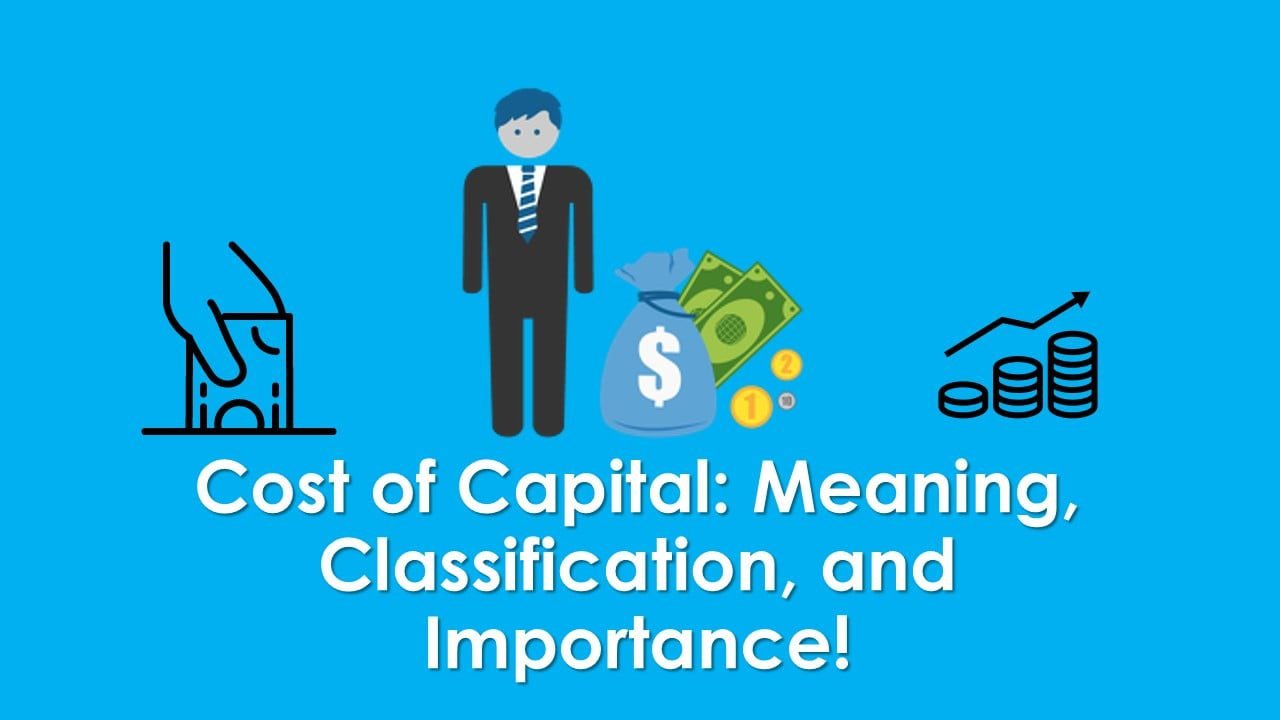Investment in capital projects needs funds. The Concept of the study Explains – Cost of Capital: Meaning, What is the Cost of Capital? Components of Cost of Capital, Significance of the Cost of Capital, Classification of Cost of Capital, and the Importance of Cost of Capital. These funds are provided by the investors like equity shareholders, preference shareholders, debenture holders, etc in expectation of a minimum return from the firm. The minimum return expected by the investors depends upon the risk perception of the investor as well as on the risk-return characteristics of the firm. Also learn, Cost of Capital: Meaning, Classification, and Importance!
Understand and Learn, Cost of Capital: Meaning, Classification, and Importance!
This minimum return expected by the investors, which in turn, is the cost of procuring funds for the firm, is termed as the cost of capital of the firm. Thus, the cost of capital of a firm is the minimum rate of return that it must earn on its investments in order to satisfy the expectation of the various categories of investors who have invested in the firm.
What is the Cost of Capital?
Meaning By accounting coach: The cost of capital is the weighted-average, after-tax cost of a corporation’s long-term debt, preferred stock, and the stockholders’ equity associated with common stock. The cost of capital is a percentage and it is often used to compute the net present value of the cash flows in a proposed investment. It is also considered to be the minimum after-tax internal rate of return to be earned on new investments.
By Wikipedia: In economics and accounting, the cost of capital is the cost of a company’s funds (both debt and equity), or, from an investor’s point of view “the required rate of return on a portfolio company’s existing securities”. It is used to evaluate new projects of a company. It is the minimum return that investors expect for providing capital to the company, thus setting a benchmark that a new project has to meet.
A firm procures funds from various sources by issuing different securities to finance its projects. Each of these sources of finance entails the cost to the firm. Since the minimum rate of return expected by various investors – equity investor and debt investor – will be different depending upon their risk perception of the firm, the cost of each source of finance will be different. Thus the overall cost of capital of a firm will be the weighted average of the cost of different sources of finance, with the proportion of each source of finance as the weight. Unless the firm earns this minimum rate of return, the investors will be tempted to pull out of the company, let alone, to participate in any further capital issue.
We have seen that the cost of capital of a firm is the minimum required rates of return of various investors – shareholders and debt investors- who supply funds to the firm. How does a firm determine the required rates of return of each investor? The required rates of return are market determined and are reflected in the market price of each security. An investor, before investing in a security, evaluates the risk-return profile of investment and assigns a risk premium to the security. This risk premium and the expected return of an investor is incorporated in the market price of the security. Thus the market price of a security is a function of the return expected by the investors.
Basic three Components of Cost of Capital:
There are various sources of finance that are used by the firm for financing its investment activities. The major sources are equity capital and debt. Equity capital represents ownership capital. Equity shares are financial instruments to raise equity capital. A debt may be in the form of secured/unsecured loans, debentures, bonds, etc. The debt carries a fixed rate of interest and the payment of interest is mandatory irrespective of the profit earned or loss incurred by the firm.
Since interest payable on debt is tax deductible, the usage of debt provides a tax shield to the company. Basic three components as follows:
- Cost of Equity Share Capital: Theoretically, the cost of equity share capital is the minimum return expected by the equity investors. The minimum return expected by the equity investors depends upon the risk perception of the investor as well as on the risk-return complexion of the firm.
- Cost of Preference Share Capital: The cost of preference share capital is the discount rate which equates the net proceeds from the issue of preference shares to the present value of the expected cash outflows in the form of dividend and principal repayment on redemption.
- Cost of Debentures or Bonds: The cost of debentures or bonds is defined as the discount rate which equates the net proceeds from the issue of debentures to the present value of the expected cash outflows in the form of interest and principal repayment.
Basic Significance of Cost of Capital:
The basic objective of financial management is to maximize the wealth of the shareholders or the value of the firm. The value of a firm is inversely related to the cost of capital of the firm. So in order to maximize the value of a firm, the overall cost of capital of the firm should be minimized.
The cost of capital is of utmost importance in capital structure planning and in capital budgeting decisions.
- In capital structure planning a company strives to achieve the optimal capital structure in order to maximize the value of the firm. The optimal capital structure occurs at a point where the overall cost of capital is minimum.
- Since the overall cost of capital is the minimum rate of return required by the investors, this rate is used as the discount rate or the cut-off rate for evaluating the capital budgeting proposals.
The Classification of Cost of Capital:
The cost of capital defines as the minimum rate of return a firm must earn on its investment in order to satisfy investors and to maintain its market value. It is the investors required the rate of return. Cost of capital also refers to the discount rate which is used while determining the present value of estimated future cash flows. The major classification of the cost of capital is:
Historical Cost and future Cost:
Historical Cost represents the cost which has already been incurred in financing a project. It is calculated on the basis of the past data. Future cost refers to the expected cost of funds to be raised for financing a project. Historical costs help in predicting future costs and provide an evaluation of the past performance when compared with standard costs. In financial decisions, future costs are more relevant than historical costs.
Specific Costs and Composite Cost:
Specific costs refer to the cost of a specific source of capital such as equity shares, Preference shares, debentures, retained earnings etc. Composite cost of capital refers to the combined cost of various sources of finance. In other words, it is a weighted average cost of capital. It is also termed as ‘overall costs of capital’. While evaluating a capital expenditure proposal, the composite cost of capital should be as an acceptance/ rejection criterion. When capital from more than one source is employed in the business, it is the composite cost which should be considered for decision-making and not the specific cost. But where capital from only one source is employed in the business, the specific cost of those sources of capital alone must be considered.
Average Cost and Marginal Cost:
The average cost of capital refers to the weighted average cost of capital calculated on the basis of the cost of each source of capital and weights are assigned to the ratio of their share to total capital funds. The marginal cost of capital may be defined as the ‘Cost of obtaining another dollar of new capital.’ When a firm raises additional capital from only one source (not different sources) than marginal cost is the specific or explicit cost. Marginal cost is considered more important in capital budgeting and financing decisions. Marginal cost tends to increase proportionately as the amount of debt increase.
Explicit Cost and Implicit Cost:
Explicit cost refers to the discount rate which equates the present value of cash outflows or value of the investment. Thus, the explicit cost of capital is the internal rate of return which a firm pays for procuring the finances. If a firm takes the interest-free loan, its explicit cost will be zero percent as no cash outflow in the form of interest is involved. On the other hand, the implicit cost represents the rate of return which can be earned by investing the funds in the alternative investments. In other words, the opportunity cost of the funds is the implicit cost.
Implicit cost is the rate of return with the best investment opportunity for the firm and its shareholders that will be forgone if the project presently under consideration by the firm were accepted. Thus implicit cost arises only when funds are invested somewhere, otherwise not. For example, the implicit cost of retained earnings is the rate of return which the shareholder could have earn by investing these funds if the company would have distributed these earning to them as dividends. Therefore, the explicit cost will arise only when funds are raised whereas implicit cost arises when they are used.
The Importance of Cost of Capital:
The cost of capital is a very important concept in financial decision making. Cost of capital is the measurement of the sacrifice made by investors in order to invest with a view to getting a fair return in future on his investments as a reward for the postponement of his present needs. On the other hand from the point of view of the firm using the capital, cost of capital is the price paid to the investor for the use of capital provided by him. Thus, the cost of capital is the reward for the use of capital. The progressive management always likes to consider the importance cost of capital while taking financial decisions as it’s very relevant in the following spheres:
Designing the capital structure:
The cost of capital is the significant factor in designing a balanced and optimal capital structure of a firm. While designing it, the management has to consider the objective of maximizing the value of the firm and minimizing the cost of capital. Comparing the various specific costs of different sources of capital, the financial manager can select the best and the most economical source of finance and can design a sound and balanced capital structure.
Capital budgeting decisions:
The cost of capital sources as a very useful tool in the process of making capital budgeting decisions. Acceptance or rejection of any investment proposal depends upon the cost of capital. A proposal shall not be accepted till its rate of return is greater than the cost of capital. In various methods of discounted cash flows of capital budgeting, cost of capital measured the financial performance and determines the acceptability of all investment proposals by discounting the cash flows.
Comparative study of sources of financing:
There are various sources of financing a project. Out of these, which source should be used at a particular point in time is to be decided by comparing the costs of different sources of financing. The source which bears the minimum cost of capital would be selected. Although the cost of capital is an important factor in such decisions, equally important are the considerations of retaining control and of avoiding risks.
Evaluations of financial performance:
Cost of capital can be used to evaluate the financial performance of the capital projects. Such as evaluations can be done by comparing the actual profitability of the project undertaken with the actual cost of capital of funds raised to finance the project. If the actual profitability of the project is more than the actual cost of capital, the performance can be evaluated as satisfactory.
Knowledge of firms expected income and inherent risks:
Investors can know the firms expected income and risk inherent therein by the cost of capital. If a firms cost of capital is high, it means the firms present rate of earnings is less, the risk is more and capital structure is imbalanced, in such situations, investors expect the higher rate of return.
Financing and Dividend Decisions:
The concept of capital can be conveniently employed as a tool for making other important financial decisions. On the basis, decisions can be taken regarding dividend policy, capitalization of profits and selections of sources of working capital.
In sum, the importance of cost of capital is that it is used to evaluate the new project of the company and allows the calculations to be easy so that it has a minimum return that investor expectations for providing investment to the company.















